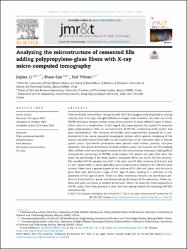| dc.contributor.author | Li, Jiajian | |
| dc.contributor.author | Cao, Shuai | |
| dc.contributor.author | Yılmaz, Erol | |
| dc.date.accessioned | 2023-11-09T07:49:08Z | |
| dc.date.available | 2023-11-09T07:49:08Z | |
| dc.date.issued | 2023 | en_US |
| dc.identifier.citation | Li, J., CAo, S. & Yılmaz, E. (2023). Analyzing the microstructure of cemented fills adding polypropylene-glass fibers with X-ray micro-computed tomography. Journal of Materials Research and Technology, 27, 2627-2640. https://doi.org/10.1016/j.jmrt.2023.10.104 | en_US |
| dc.identifier.issn | 2238-7854 | |
| dc.identifier.uri | https://doi.org/10.1016/j.jmrt.2023.10.104 | |
| dc.identifier.uri | https://hdl.handle.net/11436/8649 | |
| dc.description.abstract | Fiber reinforced cementitious tailings backfill (FRCTB) is progressively employed in mining industry due to its high strength/stiffness-to-weight ratio. However, the wide use of the FRCTB technique requires further study of the practice of many different types of fibers, either alone or in combination. In this regard, this paper explores the impact of composite (glass-polypropylene) fibers on microstructure of FRCTBs considering weak surface and pore characteristics. The fractures of backfills were quantitatively analyzed by a non-destructive X-ray micro-computed tomography system which permits imagining of the interior microstructures of backfills via the construction of 3D volumetric data in diverse spatial scales. Quantitative parameters cover percent weak surface, porosity, and pore sphericity. The spatial distribution of weak surfaces, pores, and fissures and the bridging effect of fibers were also analyzed based on the 3D reconstruction technique. Adding fibers increased the percentage of FRCTB's weak surface. The greater the glass fiber dose, the larger the percentage of the weak surface. Composite fibers can lessen FRCTB's porosity. The smallest FRCTB porosity was 0.07 % for glass and PP fiber contents of 0.4 wt% and 0.2 wt%, respectively. A rise in glass fiber dose causes a rise in volume of 10–100 mm3 pore content. Fibers have a greater impact on the volume of 0.1–100 mm3 pores, and the rise in glass fiber dose deteriorates shape of this type of pores, leading to a reduction in the sphericity of this type of pores. There is a clear correlation between the distribution patterns of weak surfaces, pores, and fissures along the height of the specimens. Weak surfaces and pores are prone to develop as fractures. Fibers can limit the crack expansion in FRCTB. Lastly, this study presents a time- and cost-saving method for analyzing FRCTB's microstructure. | en_US |
| dc.language.iso | eng | en_US |
| dc.publisher | Elsevier | en_US |
| dc.rights | info:eu-repo/semantics/openAccess | en_US |
| dc.subject | 3D model reconstruction | en_US |
| dc.subject | CT scan | en_US |
| dc.subject | Fiber-reinforced backfill | en_US |
| dc.subject | Microstructure | en_US |
| dc.subject | Pore features | en_US |
| dc.title | Analyzing the microstructure of cemented fills adding polypropylene-glass fibers with X-ray micro-computed tomography | en_US |
| dc.type | article | en_US |
| dc.contributor.department | RTEÜ, Mühendislik ve Mimarlık Fakültesi, İnşaat Mühendisliği Bölümü | en_US |
| dc.contributor.institutionauthor | Yılmaz, Erol | |
| dc.identifier.doi | 10.1016/j.jmrt.2023.10.104 | en_US |
| dc.identifier.volume | 27 | en_US |
| dc.identifier.issue | 2627 | en_US |
| dc.identifier.startpage | 2640 | en_US |
| dc.relation.journal | Journal of Materials Research and Technology | en_US |
| dc.relation.publicationcategory | Makale - Uluslararası Hakemli Dergi - Kurum Öğretim Elemanı | en_US |


















